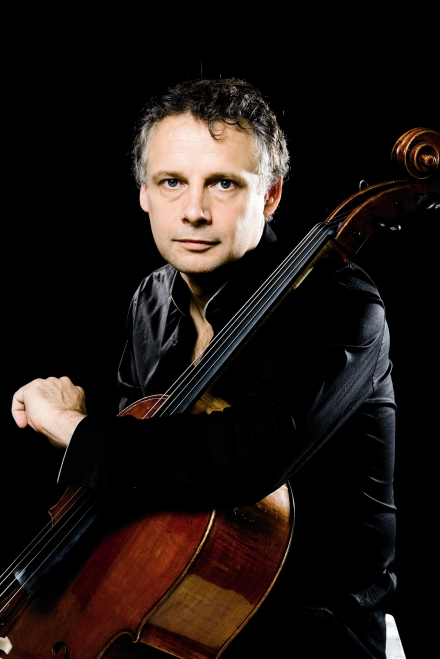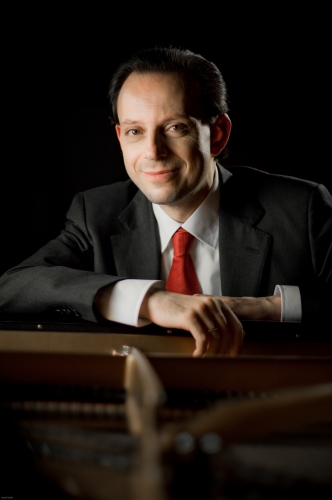Wispelwey, Giacometti prove wonderfully creative borrowers at Jordan Hall

Cellist Pieter Wispelwey performed Friday night at Jordan Hall, an event presented by the Celebrity Series of Boston.
Cello players have poached on the violin repertoire since forever, but it takes a cheeky cellist indeed to present a recital in which every work but one is a string family hand-me-down.
Friday night, Celebrity Series of Boston presented cellist Pieter Wispelwey and pianist Paolo Giacometti at New England Conservatory’s Jordan Hall, performing adapted works by Brahms, Schubert, and Stravinsky, with only George Crumb’s Sonata for Solo Cello heard in its original medium.
If this seems strange coming from Wispelwey, a recognized expert on performance practice in earlier eras, he would no doubt counter that, until recently at least, few things have been more “authentic practice” than playing somebody else’s music on your own instrument. The only question is: Does it work?
Of the three arranged pieces on this program, the most questionable in that regard was Brahms’s Violin Sonata No. 1, Op. 78. Prior to this piece, Brahms had composed no duo sonatas at all, believing that the modern piano of his day (and ours) was too overpowering a partner for any other single instrument.
Only when he hit on the idea of a sonata based on the sonorities of vocal lieder did Brahms pair a violin and a piano in such a piece; Op. 78 was to remain the most subtle and poetic of all his chamber works. In 1897, the last year of Brahms’s life, Paul Klengel arranged the sonata for his brother Julius, a noted cellist. As often happens when songs are shifted from high voice to low, Klengel changed the key from the original G major to brighter D major, putting the music in the sweet spot of the cello’s range.
On Friday night, seated in front of a Steinway concert grand with the lid up, Wispelwey risked having his low-pitched sound swallowed up in thick Brahmsian piano textures. But for the most part, with the help of the key change, pianist Giacometti’s discretion (including liberal use of the una corda pedal), and the cellist’s intense concentration and introspection, a convincing performance of Brahms’s “song sonata” emerged.

Paolo Giacometti Photo: Jonas Sacks
On the other hand, Schubert intended his Fantasy in C major, D. 934, to be a showpiece for both violinist and pianist, inspired (as Wispelwey reminded the audience in a brief comment from the stage) by Schubert’s hearing a recital by Paganini. In the course of several brilliant variations on one of the composer’s own songs—interspersed with other material, including a mysterious tremolo introduction that returns near the end—Wispelwey merrily matched Giacometti scale for scale, banishing all thoughts of whether the cello was the “right” instrument or not. He could likely have made a convincing case on a kazoo if he’d wanted.
Born in 1929, George Crumb composed hundreds of pieces before developing into the musical visionary we know today, and he has preserved almost nothing that he wrote during his twenties. A welcome exception is the Sonata for Solo Cello, composed in 1955, a work whose three movements (like Friday’s recital program itself) trace an expressive arc from introspection to showing off.
Wispelwey vividly projected Crumb’s changing moods, from the first movement’s impassioned monologue punctuated by enigmatic strummed chords, to a ghostly dance in skipping siciliano rhythm, to a brief and furious toccata, a marvel of flashing spiccato and other bow wizardry.
In 1934, Stravinsky and violinist Samuel Dushkin arranged Suite Italienne, destined to become a violin recital favorite, from portions of the ballet Pulcinella. This was not the first Suite Italienne, however; a version by Gregor Piatigorsky for cello and piano, with a slightly different selection of movements, preceded it by two years. Both pieces are made up of dances and arias attributed to the Baroque composer Pergolesi, charmingly Stravinsky-ized with tangy “wrong” notes and displaced rhythms.
Performing the Piatigorsky version, the well-seasoned duo of Wispelwey and Giacometti played as one with delicious flexibility and wit through the suite’s five movements. Stomping like country folk one moment and intoning a noble melody the next, they turned a modern lens on the wealth of musical expression that is our legacy from the 18th century.
The evening closed with two encores: Fauré’s hypnotic song Après un rêve, and a hilarious rendition of Chopin’s Valse brilliante in E flat, Op. 18, with fast repeated notes a pianist could only dream of.
The next recital of the Celebrity Series of Boston is Sérgio and Odair Assad, duo guitarists, at NEC’s Jordan Hall 8 p.m. Friday, Feb. 10. celebrityseries.org. 617-482-6661.
Posted in Performances